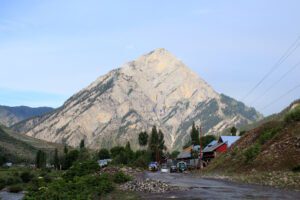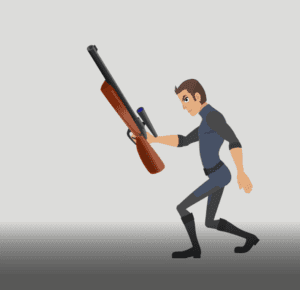Was Prehistoric Man available in Kashmir?
Nil Mat Purana a Sanskrit text 6th century A.D. of Kashmir states that when gods succeeded to drain the lake, man was brought here by then from the neighboring regions.
Explorers like Deterra and Paterson also believed that he could have lived here because the situation was congenial then. Archaeologists like H.D. Saukalia, R.V. Joshi and other explored many upper valleys and formed some man-made tools. These showed that man certainly was available in Kashmir during the Pleistocene.
What was the culture of Paleolithic man in Kahmir?
The Paleolithic man lived in Kashmir beyond the lake shores, on the higher reaches of the mountains where he had plenty of game to live on. He had large shady trees to protect himself from extreme sun-heat and rain…
Kashmir Tourism, Prehistoric Kashmir
Man has always been ambitious to know his ancestors, their culture, mode of living, implements and tools they used to put in use. And all that related with their life. Kashmir, having been a great center of art and culture during ancient and medieval period, has attracted the attention of various visitors, researchers and Media persons. But a very little has been discussed and highlighted about ancient art and culture of Prehistoric Kashmir viz archaeological excavations. Kashmir Tourism
Buddha Idol Bronze sculpture in Kashmir
The excavated tools and implements from various parts in the valley also suggest the culture and traditions of the people at the time when these tools were used.
To study Kashmir is fascinating, be it Socially, economically, Culturally, Historically, Archaeologically or geologically. It is always absorbing to look around and find such geophysical formation that are unique to the land: live moraine deposits, glacial washes, erratic, boulder clays, conglomerates Karavas. Kashmir Tourism
How were these formations laid?
Kashmir is one among mountains regions of the world. After the land formation was laid here, we had here a north area south dip. Accordingly, water drained on the southern side, almost the way the river Chenab flows now. The height of the Pir Panjal range was very low, almost 3000 meters, than it is today.
Climatically Kashmir was a hot place as other tropical regions of India. The heat of Indian planes passed over easily over the lower height of the Pir Panjal range. This situation continued till the middle of Pliocene. Kashmir Tourism
Suddenly there happened major tectonic upheavals which raised the height of the Pir Panjal by about 1700 meters, resulting in getting drainage of Kashmir blocked. The all-highland waters rushing from mountains got accumulated with mountains ranges of the Himalayan flank on the Ureta. The Pir Panjal range is south Kashmir valley turned into a vast lake without any outlet.
Pir Panjal
After a long period, another strong upheaval of Pir Panjal took place and its height raised up to 3000 mts. Because of the rise of Pir Panjal range the heat of the Indian planes got blocked. Accordingly, the climate of Kashmir changed from sub-tropical to present day temperature. In between there were very cold and dry spells of climate interrupted by warm conditions. The annual snow fall changed into thick glaciers which occupied all the mountains ridges and their valleys. Kashmir Tourism
The moraine deposits, erratic boulder clays, and conglomerates got formed, all available in high altitude mountain regions. During the colder period, conifers grew, while when climate was warm oaks grew in Kashmir. Large animals like giraffe, elephants, and rhinoceros roamed around the valley lake.
When all these happenings occurred was there any possibility for man to live in Kashmir?
Nil Mat Purana a Sanskrit text 6th century A.D. of Kashmir states that when gods succeeded to drain the lake, man was brought here by then from the neighboring regions.
Explorers like Deterra and Paterson also believed that he could have lived here because the situation was congenial then. Archaeologists like H.D. Saukalia, R.V. Joshi and other explored many upper valleys and formed some man-made tools. These showed that man certainly was available in Kashmir during the Pleistocene.
Two of these tools are earliest in Asia, of these, a tool found at Pahalgam is a crudely made Flake, used for cutting and scraping of hunted animals. It was found from a deposit which was laid at the end of first glacial stage- sometime around 2.14 m.y.b.p. (Million Years Before Present) Kashmir Tourism
Many other tools were discovered during excavation by archaeologists in different periods like hand Axe. Technologically, this was the first technique adopted by the man for making hand axe. This axe was found from a bed, laid around 1.6 m.y.b.p. Similar looking Paleolithic tools were also collected from Sonamarg, Gulmarg and Shupian- all high-altitude valleys and belong to a period when valley lake was still growing.
Paleolithic man
The Paleolithic man lived in Kashmir beyond the lake shores, on the higher reaches of the mountains where he had plenty of game to live on. He had large shady trees to protect himself from extreme sun-heat and rain. Kashmir Tourism
The recent findings of Paleolithic tools around Manasbal Lake located at the foot of the Sind valley give us an idea that at later stage of the Paleolithic culture man shifted himself from higher reaches to lower ones, living nearer the vast valley lake near its shores.
These tools are evolved than the earlier ones, Acheulean technique was adopted for their make. They are smoother and smaller in size. These tools were collected near the caves that are still available. These caves are large enough to accommodate a large group of people. Not only these cave dwelling may have protected man from the hazards of climate or weather, but there also, living together would have allowed to socialize among themselves. Kashmir Tourism
Karewas
After the drainage of water and consolidation of Karewas, man shifted himself on these Karewas. Latest of Palaeolithic tools were found on these Karewas.
On these Karewas man continued to grow, evolve and spread. In the middle of Holocene, he left many of his imprints there. He started to reshape his tools, even though for sometime, the earlier tool types continued. Kashmir Tourism
These new tool types finally changed his outlook and gave rise to new culture called NEOLITHIC.
Neolithic culture is an advanced prehistoric culture. Here man abandons wandwring for years to come. He finally settles down to live at one place and thus creates a new life pattern.
Neolithic sites P India
A large number of Neolithic sites have been found in Kashmir throughout its length and breadth, showing how, extensively this culture had spread in Kashmir. Of these sites Burzaham have been excavated. All these Neolithic sites are situated on elevated land, mostly on Karewa tops. Burzham site is likewise located on a Karewa top. It has panoramic view. Mountain Mahadeva is on one side; the famous Dal Lake is nearby. Extensive Agricultural fields are all around. Kashmir Tourism
Burzahama was first excavated in 1930′ s by H.De.Terra. These excavations were for a brief period but gave an idea about the material culture of new stone age. Thereafter extensive excavations were conducted from 1960-1971 by a team of Archeologists led by T.N.Khazanchi. Kashmir Tourism
Houses
The vertical excavations conducted by Khazanchi exposed a lot of material culture. It showed that the neolithic habitation deposits were laid here at the different cultural stages, one following the other without any break. The first period started at the base, on the natural soil, around 3000 B.C and continued till 2500 B.C.
In this period man made semi subterranean houses by digging about 1 meter deep square pits. On the periphery of these pits were raise wooden posts at intervals. The gap between the posts were filled by twigs and reeds. To make such walls of the houses strong these were plastered with clay to form the wattle and daub walls.
Chunks of such plastered walls still carry the reed impressions. These compact houses had a cooking place in there centers. Storage places was outside the houses in the form of pits with wide base and narrow mouth.
At the next stage, starting around 2500 B.C and lasting till about 1700 B.C, such pit houses were abandoned. And only over-ground houses of mud, mud bricks and timber were made. These had compact floors often painted with red ochre. Kashmir Tourism
In the last stage, dated 1700-1000 B.C, besides houses of II stage, rubble structures were also built.
Culture
The material culture exposed during the excavation is varied and numerous.
Of these stone tools alone were 1500 in number. They are:
- Celts
- Adze
- Chisel
- Wedges
- Mace heads
- Harvesters
- Muller
- Pounder
- Pickaxes
- Hoes.
Similarly, some 2000 bone tools were found there, which are: Prehistoric Kashmir India
- Points
- Arrow heads
- Awls
- Needles
- Spears
- Harpoons.
All these tools were utilized for different purposes, for example Celt was used for splitting wood, Adze for dressing of wood. Hoe, Pick-axe, mace-head, for agriculture operations. Harvesters for harvesting food plants. Mullers, Pounders for processing of food items. Arrow heads, Points were used for hinting, awls and needles for stitching and harpoons for fishing.
These people developed pottery for the time around 2500 B.C. This was hand-made thick and coarse. Subsequently around 200 B.C they made thinner pottery with brushing marks.
Agriculture
With open fields around they started agriculture operations as well. They cultivated wheat, Barley, Rice as well as masur and pea. Wheat was their principal crop about 70%. rice was introduced around 2000 B.C and was limited up to 9%. Kashmir Tourism
Besides agriculture operations they used to hunt wild animals. Around 2700 B.C they started domestications of pet animals like Sheep, Goat, Cattle. They killed for food as well. Pig was reared around 2000 B.C. Kashmir Tourism
Rituals
From 2500 B.C onwards they buried their dead in built-in graves. Mostly such graves were dug under the house floors. The dead were kept in graves in different postures. Man usually faced the sky in stretched poses, some in reclining poses. Children and females were in embryonic poses. The dead after the desiccation of flesh were re-exposed and skeletal remains were painted with red ochre.
It is generally held that these people believed in souls and life after death and therefore mortal remains were painted with red color. Some were buried with their utensils. Many were buried with personal ornaments like necklaces which were made of steatite, agate, carnelian.
Many were offered ford at different stages after their burial. They therefore believed in rituals.
Plantations of huge megaliths at the site was late phenomenon towards the closing stage of this culture. These were not commemorative but rather ritualistic in nature. It involved huge expenditure of labour to plant such stones, and many have been planted at the commands of the Priest class that may have developed among them. Possibly because of their metaphysical orientation they also buried their dead animals, like goat, dog etc. in prepared graves like humans were buried.
Ashoka
The excavation of Neolithic sites has exposed a culture of people who for the first time adopted a lifestyle that became the foundation stone for the cultures to come. It is evident from the excavations at Semthan site which is on a Karewa top. Here excavations were made by H.K.Naryan and K.S. Bist in 1979-80.
The excavation conducted revealed that man settled here at Semthan soon after the Neolithic culture ended. Kashmir who was culturally different at that time. He had no stone tools but used iron implements, copper and iron objects. In addition to that he made now new pottery types. His houses were made mostly of mud and wood. Kashmir Tourism
The journey of man continued further till he received the impetus from the Mauryan Cultures of Indian plains. When N.B.P (the northern black pottery developed during the Mauryan period in India) was introduced in Kashmir, it is certain that this pottery was introduced during the rule of Ashoka the great of 3rd century B.C. Kashmir Tourism
Rajtarangni
Kalhana in his monumental book, Rajtarangni- the history of Kashmir written in 1149 A.D, mentions a King named Ashoka, who like Mauryan Ashoka was a Buddhist.
Without any further break, the cultures at Semthan continued to grow. Following Ashoka, Indo-Greek elements were also found here. Even though Kalhana is not specific about their rule in Kashmir, yet the excavations conducted showed their presence, in the form of many terracotta figurines of Greek origin.
The continuous history of Kashmir is further revealed by the antiquities belonging to Kushanas. Kalhana mentions 3 rulers of Yue-Chi tribe of Central Asia in Rajtarangni that ruled Kashmir.
The antiquities of Kushana period at Semthan reveal for the first time, how man developed aesthetic tastes within the time. Kashmir Tourism
Kushanas
Kushanas were art lovers, and they inherited the vast empire of artists from the dominions of Scythian, Parthians, Greeks, Central Asians, Indians. As such the artist of the time made full use of many traditions to develop distinct art tradition.
Looking upon some of the antiquities found at Semthan, one finds what modelling of Clay could exhibit? These terracotta figures depict different dress, pattern. This modelling and designing of figure seem to have been inspired by a figure form from Gandhara. Kashmir Tourism
A further improvement of this designing is found in a sculpture found at Bijbehara in Kashmir. The Plastic art of Kushanas got a new dimension when their artists made figurative pavements in and around the religious buildings. These are in the form of tiles, stamped out of mold and are carrying various scenes.
These tiles were found at more than ten sites in Kashmir. Many of these have been excavated partially or extensively. Kashmir Tourism
Harwan is one such site where tile pavements were found which are located near the Famous Mughal gardens and the Dal Lake. Harwan became the first religious site during the early years of 1st century A.D. Many Buddhist endowments were raised, their relics of which are still present here. Kashmir Tourism
It is a terraced site where we find three masonry styles of construction:
- Pebble
- Diaphragm Pebble
- Rubble
Tile pavements were around the apsidal temple. These tiles were laid in Concentric circles with a three-dimensional Kamal Gatha in the center. India
BRIEF DISCRIPTION OF ART AND CULTURE OF EARLY MAN
- 4 million years B.P. evolution of Kashmir
- Neolithic Bone Tools
- Paintings of Early man
- Tools like
- Bone tools
- Stone tools, etc.
- Figures
- Coins
- Sculpture
- Caves
- Pottery
- Buddhist sites
3rdCentury B.C. Prehistoric Kashmir India
- Masonry
- Chaitya, Stupa, etc.
- Rubble structure
- Dancing girl
- Buddha
- One headed Buddha
- Crowned Buddha
- Yaksha
- Bhairva
- Pandrenthan
- Chamunda
- Jaishnavi
- Headless Buddha satwa
- Pinaka Shiva
- Siddartha (birth)
- Buddha
- Eikhmukh Buddha Abin Mehjoor.
- Queen Dida.
- Buddha Bharamulla.
- 3 Headed Vishnu (green color)
- 3 Headed Vishnu
- Ushkara heads.
- Vihara
Kashmir Travel and Tourism – Kashmir fair
Duke Plus – Genuinely from Kashmir
Also Read: A Trip to Gurez








